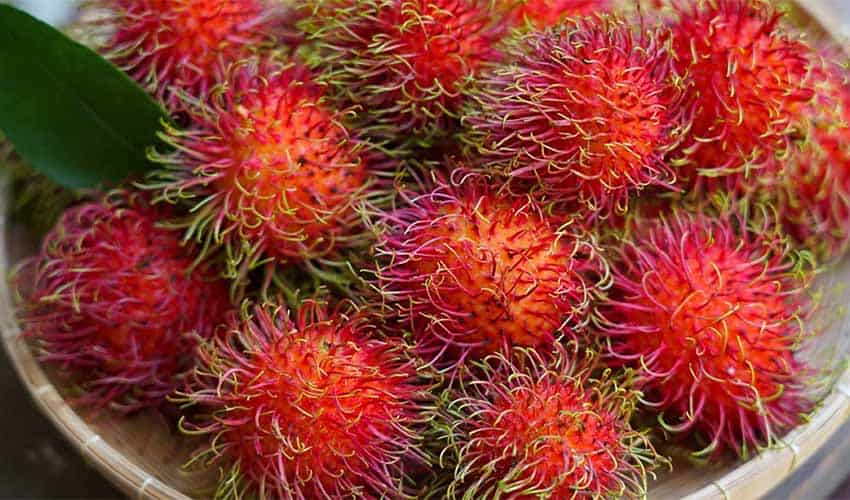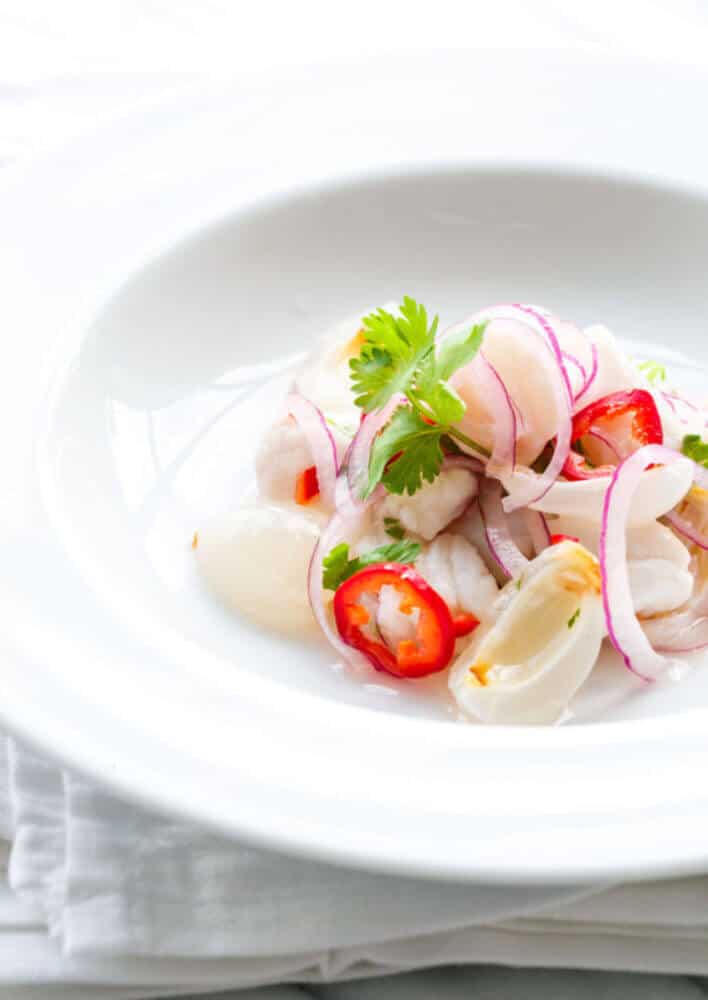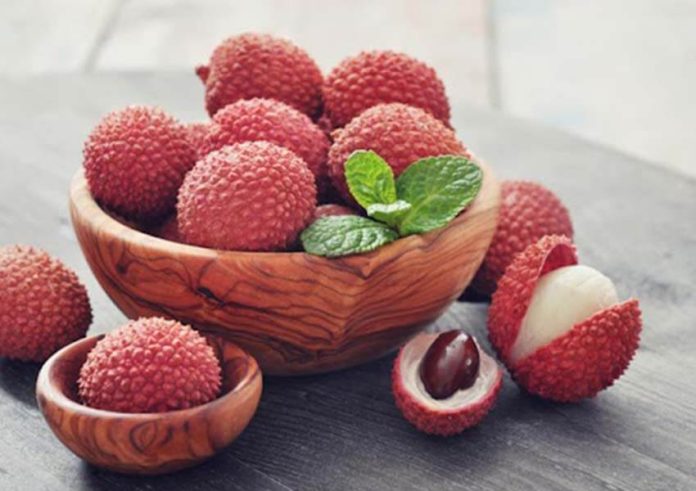My first encounter with a lychee was at Mazatlán’s organic farmers’ market, where one day a grower appeared with many boxes of the pretty, little, round red fruits. He showed me how to pinch one open; I popped it in my mouth and was hooked. Turns out the state of Sinaloa has perfect conditions for cultivating lychees and is one of the biggest producers in all of Mexico.
How did this exotic fruit, native to China, end up in Mexico?
In 1900, several hundred Chinese immigrants were given visas to work building Mexico’s railways. Their contracts allowed them to stay on, and those that did moved throughout the country. In Sinaloa, they found the climate, soil conditions and altitude to be similar to China, and some took up agriculture — especially fruit-growing. It was these Chinese migrants who introduced the lychee to Mexico.
Rambutans, while similar in taste, are the lychee’s rather wild-looking cousin, covered as they are with short and flexible red, pink and golden spikes, called spinterns. Inside is the same white globe of sweet flesh as lychees, but with a slightly different flavor. They’re grown mostly in the southern states of Chiapas and Oaxaca.

The classic rambutan experience includes a wheelbarrow full of the unusual little fruits. Indeed, I was visiting a small village outside Oaxaca city, meandering through an outdoor market, when suddenly said wheelbarrow appeared in front of me.
Enthralled by the rambutans’ cuteness (they look like alien toys), I stopped and asked the young man behind the barrow what he was selling. He picked one up and pinched it open to expose the globe of shiny, white pulp, gesturing that I should eat it, which I did.
What do they taste like, besides delicious? Well, you can’t separate the flavor from the texture, which is kind of like a grape — but not. The taste is grape-like also, with lychees a bit sweeter than rambutans. Both have a fairly big, shiny black seed in the middle of the pulp that you don’t want to eat. Lychees are ping-pong ball sized, while rambutans are closer to golf ball-size.
In Mexico, May, June and July are the biggest harvest months for lychees, depending on weather; besides Sinaloa, the state of Veracruz and the Huasteca Potosina region also grow them. Rambutan trees produce into November. Refrigerated, both fruits can keep a month or two longer.
My advice is to buy them when you see them, as the season is short!
Rambutan can be used to make preserves and chutneys; both rambutans and lychees can be used to make ice cream, be added to fruit salads or blended with vodka for an exotic martini. Personally, though, I think eating them chilled and fresh-popped out of their red skins is the way to go.
If you can’t find fresh lychees, canned ones are easily available. While not the same as fresh, they’ll work just as well in these recipes.
Lychee Bellini
- 6 lychees (if using fresh, peel and remove pits)
- 8 oz. chilled, dry sparkling wine
Puree lychees with a blender. Strain pulp with a fine mesh sieve, pushing puree through with a rubber spatula.
Fill a flute or other tall, narrow glass a third full with the lychee puree.
Slowly pour sparkling wine into glass, stirring slowly as you pour. Pause to allow foam to subside as necessary.

Lychee Ceviche
- ½ lb. fresh snapper, cut into bite-sized cubes
- ¼ cup fresh lime juice
- ¼ cup fresh lemon juice
- 1 jalapeño or serrano pepper, seeded, thinly sliced
- 8-10 lychees, pitted, cut into small pieces (about ½ cup total)
- ¼ red onion, thinly sliced
- ¼ cup packed cilantro, minced
- ¼ tsp. grated fresh ginger
- 1 Tbsp. simple syrup or reserved lychee syrup
Season fish with salt; combine with lemon and lime juice in a bowl. Add peppers and toss. Cover and refrigerate 15–20 minutes, stirring once or twice, until fish is just becoming opaque. Add lychee, onion, cilantro, ginger and simple syrup; toss to combine. Divide among serving bowls, spooning more juice over top of each.
Lychee-Chile Lemonade
- 1 lb. lychees, peeled and seeded (to make about 1½ cups lychee pulp)
- 1 cup fresh lemon juice
- ¾ cup sugar
- Pinch salt
- ½ (or less) small serrano chili
- 3 cups cold water
- 1 quart ice
Combine 1 cup lychees, lemon juice, sugar, salt and chili in blender. Process on high until smooth, about 1 minute. Strain through a fine mesh strainer into pitcher; discard solids.
Add cold water and whisk to combine. Chop remaining lychee pulp into ¼-inch pieces and add to pitcher. Add ice and serve.
Rambutan Watermelon Feta Salad
- 1 Tbsp. minced shallot
- ½ to 1 jalapeño or serrano chili, seeded, minced
- 2 tsp. honey
- 1 tsp. soy sauce
- 2 tsp. white vinegar
- 3 Tbsp. olive oil
- Salt and freshly ground black pepper
- 2 qts. seeded diced watermelon (½-inch dice)
- 1 lb. rambutans or lychees, peeled and with flesh torn into rough chunks (to make about 1½ cups)
- 5 oz. crumbled feta cheese
- ½ cup chopped basil leaves
- Optional: 1 stalk lemongrass, bottom 4 inches only, peeled and minced
Combine shallot, chili, lemongrass (if using), honey, soy sauce, and white vinegar in small bowl. Whisking constantly, drizzle olive oil into bowl. Season with salt and pepper; set aside.
Gently mix watermelon, lychees/rambutans, feta and basil in large bowl.
Add dressing; toss to combine. Serve immediately.
Lychee and Orange in Iced Syrup (Thai Loy Gaew)
- 3 cups sugar
- 1 tsp. salt
- 1 (5-inch) piece ginger, thinly sliced
- ¼ cup tightly packed grated fresh coconut
- 6 medium oranges, peeled and sectioned
- 2½ cups peeled and seeded fresh lychees, or 2 (20-ounce) cans, drained
- ½ cup chopped fresh mint
- About 1 cup finely crushed ice
In small saucepan, combine sugar, salt, ginger and 4 cups of water. Bring to boil, reduce heat to low; simmer until liquid is reduced by half, about 20 minutes. Cool.
Toast coconut in a skillet over medium-low heat, stirring and tossing continually. Remove from heat; cool. Combine oranges and lychees in large bowl. Remove and discard ginger from syrup. Pour syrup over fruit. Stir in mint. Chill.
To serve, spoon fruit mixture into six small bowls. Add about 2 Tbsp. crushed ice to each bowl; top with toasted coconut.
Janet Blaser is the author of the best-selling book, Why We Left: An Anthology of American Women Expats, featured on CNBC and MarketWatch. She has lived in Mexico since 2006. You can find her on Facebook.
